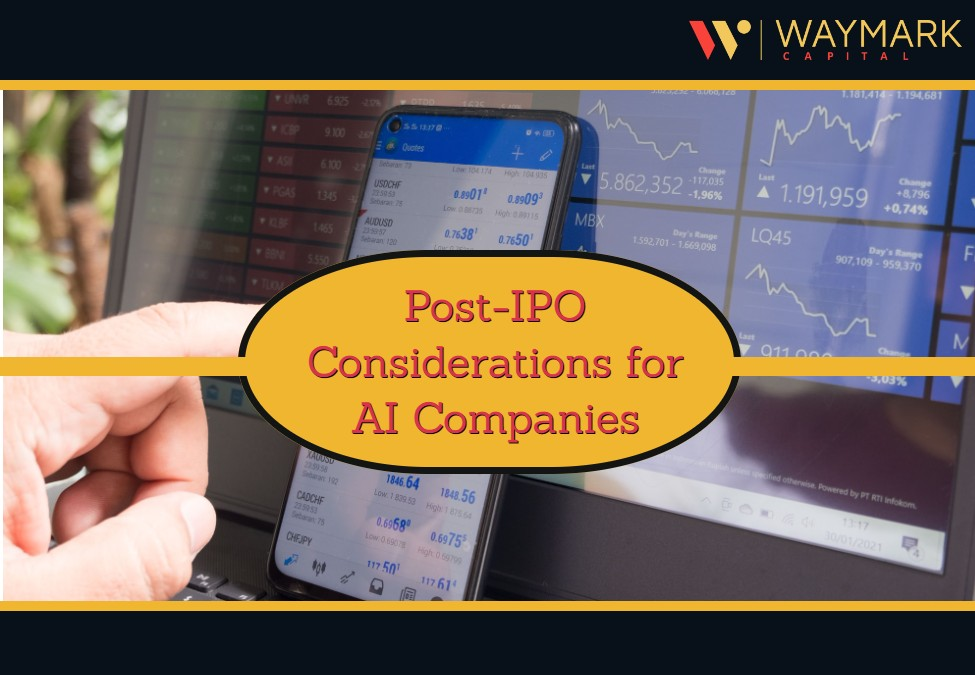
13 July 2023
You have gone through an IPO and are now listed on the public stock exchange. What happens after an IPO for AI companies? There are many things you need to put in place and some changes you need to go through to ensure a smooth transition. Let us explore these vital Post-IPO Considerations for ai companies.
After going public, an AI company may experience several changes and challenges. Here are some of the common ones:
An AI company becomes subject to increased scrutiny and transparency requirements as a publicly traded company. The company must comply with stringent reporting obligations, disclose financial information regularly, and provide transparency in its operations. This includes quarterly and annual financial reporting, shareholder communications, and regulatory filings.
At the same time, investors, analysts, and regulatory bodies may closely monitor the company’s performance and decision-making. This new reality takes some effort to get used to for most executives, but it is inevitable when a company goes public.
Publicly traded AI companies face significant pressure to meet or exceed financial expectations. Investors and analysts closely monitor financial performance, revenue growth, and profitability.
The company must deliver consistent results to maintain investor confidence and support its stock price. This can pressure management to meet short-term financial goals, which may require balancing long-term innovation and growth with meeting quarterly targets.
Going public opens the company to potential shareholder activism. Activist investors may seek to influence corporate strategy, management decisions, or board composition. The company needs to effectively manage investor relations, engage with shareholders, and address their concerns to maintain a positive relationship with its investor base.
The competitive landscape for AI companies can change rapidly. Going public may attract increased attention from existing competitors and new entrants. The company must continuously innovate, protect its intellectual property, and adapt to market dynamics to stay ahead.
The pressure to differentiate and maintain a competitive edge intensifies, requiring ongoing investment in research and development. Luckily, the capital injection that comes from a successful IPO can be used to fund these new projects.
After going public, an AI company’s ability to attract and retain top talent becomes critical. The company may need to compete with other public companies and startups to secure skilled AI professionals, data scientists, and researchers.
Stock-based compensation and attractive employee benefits packages may become necessary to attract and retain talent. The company must also create a positive corporate culture and provide growth opportunities to retain existing employees.

Publicly traded AI companies face increased regulatory scrutiny, which must form part of the post-IPO considerations for ai companies. They must navigate complex and evolving regulatory frameworks related to data privacy, security, AI ethics, and industry-specific regulations.
The company must ensure compliance with applicable laws, standards, and regulations, which may require ongoing investment in compliance programs and legal expertise.
The company must actively manage investor relations and communicate effectively with the market. It must provide timely updates, address investor inquiries, and manage market expectations. Consistent and transparent communication is crucial to maintain trust and support from shareholders and analysts.
Going public may create pressure to focus on short-term financial results. However, AI companies need to strike a balance between meeting investor expectations and investing in long-term innovation. Continued investment in research and development, expanding product offerings, and pursuing strategic partnerships are essential to drive sustained growth and maintain a competitive advantage.
Successfully navigating these challenges requires effective leadership, strategic decision-making, and a focus on long-term value creation while meeting short-term market expectations
When an AI company goes public, it becomes subject to increased transparency, accountability, and reporting requirements. Here are some critical aspects of these requirements:
Publicly traded companies are required to provide regular and detailed financial reports. This includes quarterly and annual reports that provide information about the company’s financial performance, including revenue, expenses, profit margins, and cash flow. Depending on the jurisdiction, these reports must adhere to generally accepted accounting principles (GAAP) or International Financial Reporting Standards (IFRS).
Public companies must disclose material information that may impact the company’s financial performance or the value of its securities. This includes disclosing significant events, such as mergers, acquisitions, divestitures, legal proceedings, regulatory actions, and changes in key personnel.
The company must also disclose risks, uncertainties, and forward-looking statements to provide investors with a comprehensive view of the business.
Public companies must communicate effectively with their shareholders. This includes providing regular updates on company performance, strategic initiatives, and any other information that may impact investment decisions.
Shareholders have the right to receive timely and accurate information to make informed investment decisions. Shareholder communications must form part of the Post-IPO considerations for ai companies.
Public companies are subject to various regulatory requirements and oversight by regulatory bodies such as the Securities and Exchange Commission (SEC) in the United States. Compliance with securities laws, corporate governance standards, and other regulations is essential. This includes adhering to disclosure obligations, insider trading regulations and implementing adequate internal controls to ensure accurate financial reporting.

Public companies typically undergo an annual audit conducted by an independent accounting firm. The audit objectively assesses the company’s financial statements and internal controls. It enhances credibility, assures investors of the accuracy and reliability of financial information, and demonstrates the company’s commitment to transparency.
Public companies must have a board of directors responsible for overseeing the company’s operations, governance, and strategic decision-making. The board is a fiduciary to shareholders and ensures that the company operates in its best interests. Good corporate governance practices are essential, including independent board members, board committees, and effective oversight.
Public companies are required to file various regulatory documents and disclosures. These filings may include annual reports (Form 10-K), quarterly reports (Form 10-Q), current reports (Form 8-K), proxy statements, and registration statements for securities offerings. These filings are publicly available and provide investors and regulators with detailed information about the company’s business, financials, and governance.
Public companies must establish and maintain effective investor relations programs. This involves actively engaging with shareholders, analysts, and the investment community. Regular communication, conducting investor presentations, participating in investor conferences, and responding to inquiries are essential aspects of investor relations.
Compliance with these requirements is crucial for maintaining trust and credibility with shareholders, regulators, and the broader market. It requires robust financial systems, effective governance practices, and a commitment to ethical and responsible business conduct.
A vital task that forms part of the post-IPO considerations for ai companies is to measure response and develop a blueprint for the company’s future. This shall form the basis of the rest of this discussion on Ai company IPOs:
The market’s response to an AI company’s IPO can vary depending on several factors, including market conditions, industry trends, financial performance, and investor sentiment. Here’s an overview of the possible outcomes:
An AI company’s IPO may receive a positive market response in a favorable market environment with a strong investor appetite for AI and technology stocks. This can lead to a significant increase in the stock price on the first day of trading, often referred to as the “pop.” A strong market response indicates investor confidence in the company’s growth prospects and can generate positive media coverage and investor interest.
AI company IPOs, like any other tech IPOs, can experience periods of volatility and fluctuations in the stock price. While an initial surge in stock price may occur, it can be followed by periods of consolidation or decline as the market digests the new information and adjusts its expectations. Factors such as broader market conditions, sector rotation, and news about the company can impact the stock’s performance in the short term.
Investor sentiment toward an AI company’s IPO can significantly affect its stock performance. Positive sentiment, driven by excitement about the company’s technology, market potential, or industry trends, can contribute to strong demand and a higher valuation.
On the other hand, negative sentiment, fueled by concerns about the company’s financials, competitive landscape, or broader economic conditions, can result in tepid investor interest or a lower valuation.
The long-term stock performance of an AI company post-IPO depends on its ability to deliver on its growth plans, meet or exceed market expectations, and maintain a competitive advantage. If the company demonstrates strong revenue growth, profitability, and market penetration, it can attract continued investor interest and support, leading to a buoyant stock performance over time.
However, if the company faces challenges in execution, competition, or market dynamics, the stock may experience underperformance.
Analysts often initiate coverage of newly public companies, including AI companies. Analyst reports, and ratings can influence investor sentiment and stock performance. Positive analyst coverage, favorable ratings, and price targets can attract investors and increase stock appreciation. However, antagonistic or cautious coverage can have the opposite effect, leading to selling pressure and downward pressure on the stock.
While each AI company’s IPO experience is unique, and the market response can vary significantly, post-IPO considerations cut across. It is, therefore, essential to be well-prepared for this crucial phase of your company as a decision-maker. Having the right partners to guide you in the process can go a long way in making your post-IPO period as smooth as possible.
Image Credit: